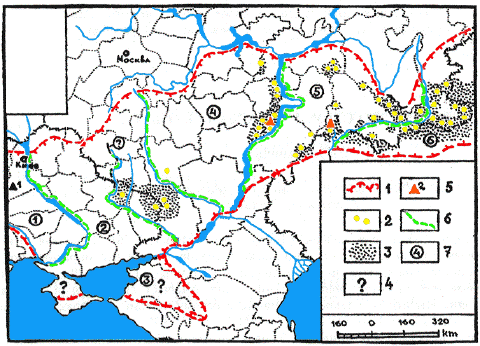Thus, we can suggest a preliminary draft scheme of subdividing the European part of the bobac area (fig.) without discussing so far the status of the structural units we define. It may be helpful in avoiding mistakes while working on artificial dispersing of marmots (see Bibikov, Dimitriev et al., present edition). Later the scheme will be updated and developed in details the base of the data on the bobac natural variability and the role of barriers, both physical and biotopical. Interesting, that even now the scheme is in good conformance with conclusions made by A.A.Nikolsky (1997, present edition) regarding variability of the species vocalization.
 Fig. The scheme of subdivisions of the European part of the bobac area.
Fig. The scheme of subdivisions of the European part of the bobac area.
1 - supposed natural border of the area; 2 - main sites where bobacs survive during peak of number depression; 3 - present natural populations; 4 - bobac presence in historical times is debatable; 5 - areas where the subspecies were first described: 1 - M. b. bobac (hypothetically), 2 - M. b. kozlovi, 3 - M. b. schaganensis; 6 - supposed borders of the species area subdivisions; 7 - supposed definitions of the subdivisions (draft): 1) West-Ukranian (no present m natural marmot settlements); 2) Dnepr-Don (or Donetsk-Don); 3) Northern Caucasian (debatable); 4) Central Russian-Volga
Region; 5) Over Volga Region (or Volga Region-Urals); 6) Urals-Turgay (in Asian part of the area - up to Turgay hollow).
Retour au sommaire / Back to Abstracts contents